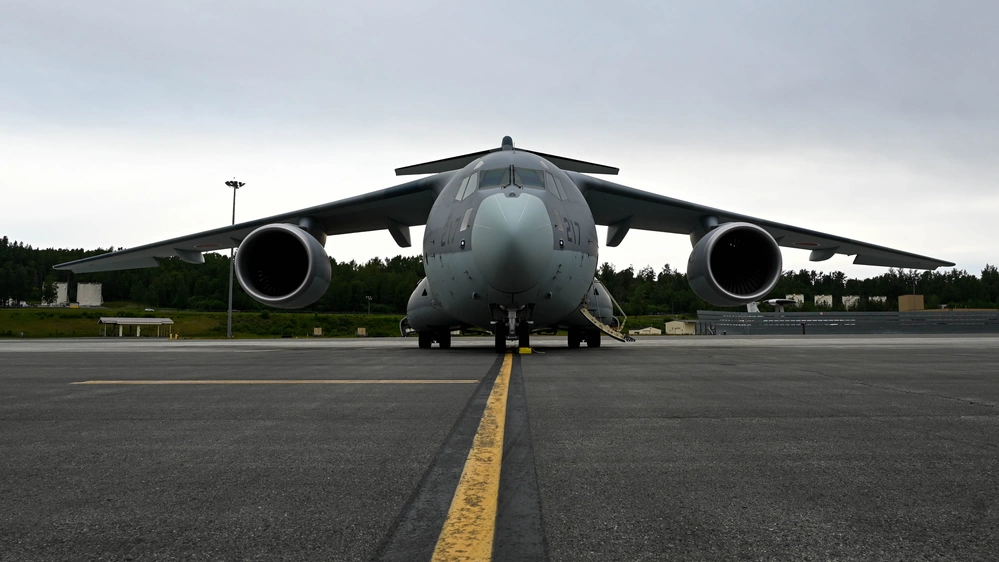U.S. Marines and Japan Air Self-Defense Force (JASDF) personnel conducted a significant loading test at Japan’s Iruma Air Base, Sayama. This operation saw the first-time integration of a U.S. Marine Corps M142 High Mobility Artillery Rocket System (HIMARS) and an Oshkosh Defense Joint Light Tactical Vehicle (JLTV) into a Kawasaki C-2 transport aircraft. The recent loading test at Iruma Air Base serves as a testament to the enduring strength of the U.S.-Japan alliance and its role in securing peace and stability in the region. The loading exercise involved Marines from the 3rd Battalion, 12th Marine Littoral Regiment, part of the 3rd Marine Division, stationed at Camp Smedley Butler, Okinawa. As a Littoral regiment, it is designed for operations in the maritime domain, capable of maneuvering quickly and maintaining a low signature. The ability to operate with platforms like the Kawasaki C-2 expands their reach and operational versatility.
The M142 High Mobility Artillery Rocket System (HIMARS), a light multiple rocket launcher, has become a key asset for rapid deployment and long-range precision strikes. Developed in the late 1990s for the U.S. Army, it is mounted on a U.S. Army Family of Medium Tactical Vehicles (FMTV) M1140 truck frame. HIMARS can carry a single pod loaded with either six Guided Multiple Launch Rocket System (GMLRS) rockets or one ATACMS missile. It is based on the U.S. Army’s FMTV five-ton truck, and is capable of launching all rockets in the Multiple Launch Rocket System Family of Munitions. HIMARS ammunition pods are interchangeable with the M270 MLRS. Designed for quick deployment, it can be transported by aircraft like the C-17 Globemaster, C-5 Galaxy, and the Lockheed C-130 Hercules. The successful loading of the HIMARS into the Kawasaki C-2 marks an important first for joint U.S.-Japan mobility capabilities.

The Joint Light Tactical Vehicle (JLTV), developed by Oshkosh Defense, serves as a versatile multi-role combat vehicle for the U.S. military. Initially designed to replace the older HMMWV (Humvee) fleet, the JLTV offers improved protection comparable to heavier Mine Resistant Ambush Protected (MRAP) vehicles while maintaining high mobility. It is available in multiple configurations, including Utility, Close Combat Weapons Carrier, and General Purpose models, each tailored for specific mission needs. Since achieving initial operating capability in the U.S. Marine Corps in 2019, the JLTV has become integral to expeditionary forces. Its inclusion in the recent Kawasaki C-2 loading test underscores its adaptability in joint operations. Japan was looking for a successor of the Komatsu LAV. The JLTV was one of the competitor, but only the Mowag Eagle V and the Thales Hawkei were pre-selected for evaluation.
The Kawasaki C-2, Japan’s latest mid-size, long-range military transport aircraft, entered service with the JASDF in 2016, replacing the aging C-1. Known for its superior payload capacity—up to four times greater than its predecessor—the C-2 is capable of transporting heavy military assets, such as the HIMARS and Patriot missile batteries, over long distances. While sharing fuselage components with the Kawasaki P-1, the fuselage of the C-2’s is substantially larger to accommodate a vast internal cargo deck, which is furnished with an automated loading/unloading system to reduce workloads on personnel and ground equipment. It is equipped with advanced avionics, including a full glass cockpit, fly-by-wire controls, and an automated cargo loading system, making it ideal for rapid deployment operations. With its ability to support heavy payloads and operate on shorter runways, the C-2 is a vital asset for Japan’s defense strategy, and now, it demonstrates the capacity to transport key U.S. military assets.
















